Brazil has pledged its renewed commitment to developing a rocket program in spite of the terrible disaster that killed 21 people at the Alcantra launch facility in August. They now plan to have a new rocket completed in 2006 and are willing to pay the $22 million required to repair the platform and equipment destroyed in the explosion. The government will also be compensating the families of the technicians who died in the accident and pay for the education of their children at university.
New Targets to Search For Life on Europa
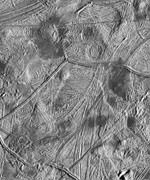
Image credit: NASA
A new study of Jupiter’s moon Europa may help explain how giant ice domes can form on its surface; places which could contain life. The study predicts that impurities in the water, like salt or sulfuric acid, could be the mechanism that allows blobs of ice to be pushed up through the 13 km thick sheet of ice that covers a water ocean. These blobs could contain microbes that lived inside the ocean and they would be much more accessible to a lander than trying to pierce the moon’s icy shell.
A new University of Colorado at Boulder study of Jupiter’s moon Europa may help explain the origin of the giant ice domes peppering its surface and the implications for discovering evidence of past or present life forms there.
Assistant Professor Robert Pappalardo and doctoral student Amy Barr previously believed the mysterious domes may be formed by blobs of ice from the interior of the frozen shell that were being pushed upward by thermal upwelling from warmer ice underneath. Europa is believed to harbor an ocean beneath its icy surface.
But the scientists now think the dome creation also requires small amounts of impurities, such as sodium chloride or sulfuric acid. Basically the equivalent of table salt or battery acid, these compounds melt ice at low temperatures, allowing warmer, more pristine blobs of ice to force the icy surface up in places, creating the domes.
“We have been trying for some time to understand how these ice blobs can push up through the frozen shell of Europa, which is likely about 13 miles thick,” said Pappalardo of the astrophysical and planetary sciences department. “Our models now show that a combination of upwelling warm ice in the frozen shell’s interior, combined with small amounts of impurities such as sodium chloride or sulfuric acid, would provide enough of a force to form these domes.”
A paper on the subject co-authored by Pappalardo and Barr was presented at the annual Division of Planetary Sciences Meeting held Sept. 2 through Sept. 6 in Monterey, Calif. DPS is an arm of the American Astronomical Society. The meeting schedule is available at http://dps03.arc.nasa.gov/administrative/schedule/index.html.
Europa appears to have strong tidal action as it elliptically orbits Jupiter – strong enough “to squeeze the moon” and heat its interior, said Pappalardo. “Warm ice blobs rise upward through the ice shell toward the colder surface, melting out saltier regions in their path. The less dense blobs can continue rising all the way to the surface to create the observed domes.”
The domes are huge – some more than four miles in diameter and 300 feet high – and are found in clusters on Europa’s surface, said Barr, who did much of the modeling. “We are excited about our research, because we think it now is possible that any present or past life or even just the chemistry of the ocean may be lifted to the surface, forming these domes. It essentially would be like an elevator ride for microbes.”
Barr likened the upwelling of warmer ice from the inner ice shell to its surface to a pot of boiling spaghetti sauce. “The burner under the pan sends the hottest sauce to the top, creating the bubbles at the surface,” she said. “The trouble is Europa’s icy skin is as cold and as hard as a rock.”
The idea that either small amounts of salt or sulfuric acid might help to create Europa’s domes was Pappalardo’s, who knew about similar domes on Earth that form in clumps in arid regions. On Earth, it is salt that is buoyant enough to move up through cracks and fissures in rock formations to form dome clusters at the surface.
“In addition, infrared and color images taken of Europa by NASA’s Galileo spacecraft seem to indicate some of the ice on the surface of these domes is contaminated. Impurities seen at the surface are clues to the internal composition of the Jovian moon, telling of a salty ice shell,” he said.
“The surface of Europa is constantly being blasted by radiation from Jupiter, which likely precludes any life on the moon’s surface,” said Barr. “But a spacecraft might be able to detect signs of microbes just under the surface.”
Both Pappalardo and Barr also are affiliated with CU-Boulder’s Laboratory for Atmospheric and Space Physics. The project was funded by NASA’s Exobiology Program and Graduate Student Research Program.
Pappalardo recently served on a National Research Council panel that reaffirmed a spacecraft should be launched in the coming decade with the goal of orbiting Europa. He currently is part of a NASA team developing goals for the Jupiter Icy Moons Orbiter mission.
The scientific objectives of the mission probably will include confirming the presence of an ocean at Europa, remotely measuring the composition of the surface and scouting out potential landing sites for a follow-on lander mission.
Original Source: University of Colorado at Boulder Press Release
“Killer” Asteroid will Miss
Additional observations from astronomers have decreased the likelihood to virtually zero that Asteroid 2003 qq47 will strike the Earth in 2014. The asteroid was first discovered on August 24 by the LINEAR observatory and astronomers put its odds at 1 in 909,000 at 2003qq47 hitting the Earth, but the additional observations on Monday night extended those odds to 1 in 2.2 million, which is below the background risk of asteroid strikes on any given year. If the 1.3 km asteroid were to strike the Earth, it would cause immense damage on a continental scale… but it won’t.
Planetery Tilts Might Not Be a Big Problem
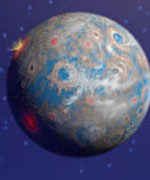
Image credit: NASA
Scientists have believed that the tilt of the Earth’s axis is very important to supporting life on our planet, but a new simulation from Pennsylvania State University seems to indicate that life could arise on our planet, even if it was severely tilted. Even when the planet was tilted past its current 23 degrees to 54, 70 and 85 degrees, global climate, rainfall, snow and ice cover closely matched today’s climate. Only when there was no tilt did the simulation predict a colder world than we have – but still largely habitable.
Erie, Pa. ? In B science fiction movies, a terrible force often pushes the Earth off its axis and spells disaster for all life on Earth. In reality, life would still be possible on Earth and any Earth-like planets if the axis tilt were greater than it is now, according to Penn State researchers.
?We do not currently have observations of extrasolar planets, but I imagine that in the near future, we will uncover some of these small planets,? says Dr. Darren M. Williams, assistant professor of physics and astronomy, Penn State Erie, the Behrend College. ?The issue before us is what will they be like? Will they have moons? What will their climates be like? Will they be teaming with life or will life be rare?
?I suspect, based on simulations and our own solar system, that many Earth-like planets will have spin axes that are tipped more severely than Earth?s axis.?
Williams, working with David Pollard, research associate in geoscience at Penn State, used general circulation climate models to simulate a variety of tilts, carbon dioxide levels and planets. They reported on their findings in the International Journal of Astrobiology.
The researchers first looked at present-day Earth with tilts of 23, 54, 70 and 85 degrees. Earth?s tilt today is about 23 degrees. The simulation that mimicked today?s Earth and tilt closely matched today?s climate, including regional precipitation patterns, snow and ice cover and drought.
?Tilts greater than the present produce global annual-mean temperatures higher than Earth?s present mean temperature of about 57 degrees Fahrenheit,? says Williams. ?Above 54 degrees of tilt, the trend is for the global annual-mean temperature to decrease as tilt increases.?
The Penn State scientist explains that this decrease occurs because more land exists north of the equator in present-day Earth. Annual-mean temperatures, however, are not the best way to determine if a planet might be habitable, as seasonal temperature variations could be extreme.
The researchers also looked at these tilted Earths with ten times the carbon dioxide in the atmosphere. Carbon dioxide as a greenhouse gas increases the temperatures on a planet. These models produced Earths with 11 to 18 degrees Fahrenheit higher annual-mean temperatures.
Because all planets will not have Earth?s geography, the researchers took a page from Earth?s history and modeled a 750-million-year-old Earth representing the Sturtian glaciation and a 540-million-year-old Earth, the closest approximation available for the Varanger glaciation.
?During the Sturtian, land masses were mainly equatorial and clumped mostly within 30 degrees of the equator,? says the Penn State Erie researcher. ?In the Varanger model, everything is close to the south pole.?
While current day Earth is about 30 percent land to 70 percent water, these ancient geographies are about 22 percent land and 78 percent water.
?The highest temperatures and seasonal variations happen with the largest land areas at the mid to high latitudes,? says Williams.
The researchers also ran some of the model Earths with zero tilt.
?Present Earth is one of the most uninhabitable planets that we have simulated,? says Williams. ?Approximately 8.7 percent of the Earth?s surface is colder than 14 degrees Fahrenheit on average, and this percentage peaks at 13.2 percent in February owing to the large landmasses at high latitude covered by snow.?
The only planets colder than today?s Earth are those planets simulated with no tilt.
The Varanger simulation, with most land in the southern hemisphere, is the most extreme with 15.6 percent of the surface below 14 degrees Fahrenheit in July and 9.3 percent of the surface above 122 degrees Fahrenheit in January. On average, nearly 28 percent of this planet?s land mass is uninhabitable by Earth standards.
?This simulation suggests that planets with either large polar supercontinents or small inventories of water will be the most problematic for life at high obliquity,? says Williams.
None of the planets with increased tilt had permanent ice sheets near the equator. This, however, does not guarantee that a world is suitable for life, the researchers note. The extremes of temperature on most of the simulated earths would make it difficult for all but the simplest Earth life forms to survive. Extremes caused because the tilt puts large portions of the planet in 24-hour darkness or 24-hour sunlight for long periods would also inhibit photosynthetic organisms.
The researchers suggest that even with high tilt, life can exist on the planets they modeled.
?Provided the life does not occupy continental surfaces plagued seasonally by the highest temperature, these planets could support more advanced life,? the researchers say. ?While such worlds exhibit climates that are very different from Earth?s, many will still be suitable for both simple and advanced forms of water-dependent life.?
So there is no reason to eliminate Earth-like planets with more tilt than Earth from future searches for life beyond the solar system.
?We have one planet and we have a lot of species on this planet, but it is only one data point,? says Williams. ?Maybe one day we will figure out everything about life on our own planet, but no where near what is possible elsewhere.?
The National Science Foundation supported this work.
Original Source: Penn State University News Release
Asteroid Risk Lowered
When Asteroid 2003 qq47 was discovered last week from a tracking system in New Mexico, astronomers predicted that it could strike the Earth in 2014. Astronomers have now made 51 observations of its orbit and determined that the chance of 2003qq47 hitting the Earth are 1 in 909,000 and additional observations will probably reduce this possibility to zero. The space rock is estimated to be 1.2 km across and traveling at a speed of 30 km/second. If it did strike the Earth, it would cause widespread destruction across an entire continent, releasing the same amount of energy as 350 billion tonnes of TNT.
Progress Docks with Station
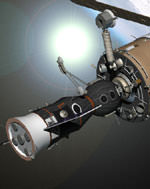
Image credit: NASA
The Russian Progress cargo ship launched last week caught up and docked with the International Space Station on Saturday. It delivered nearly three tons of food, fuel, water, supplies and scientific gear for the next crew to inhabit the station. The Progress 12 automatically linked up with the Zvezda Service Module at 0340 GMT (11:40 pm EDT Friday). Another Progress ship currently docked with the station will undock on Thursday to make room for the Soyuz that will launch with the Expedition 7 astronauts on October 20.
An unpiloted Russian resupply craft successfully docked to the International Space Station tonight, delivering nearly three tons of food, fuel, water, supplies and scientific gear to the Expedition 7 crew aboard the complex and for the next crew to launch in October.
The Progress 12 vehicle automatically linked up to the aft end of the Zvezda Service Module at 10:40 p.m. CDT (0340 GMT), two days after its launch from the Baikonur Cosmodrome in Kazakhstan. As the Progress neared the Space Station for docking, Expedition 7 Commander Yuri Malenchenko and NASA ISS Science Officer Ed Lu were inside Zvezda, monitoring its approach. At the time of contact and capture, the Station was flying over Central Asia at an altitude of 240 statute miles. After conducting leak checks to insure a tight seal between the Progress and the ISS, Malenchenko and Lu will open the hatch to the ship and then begin unloading the supplies.
Stowed in the Progress are replacement parts for Station systems, tools, a satellite telephone and Global Positioning System hardware, next generation laptop computers, educational demonstrations, science experiment gear and office supplies. The Progress also carried to the ISS science equipment for European Space Agency (ESA) Astronaut Pedro Duque of Spain, who is set to launch Oct. 18 from Baikonur on the Soyuz TMA-3 craft with Expedition 8 Commander Mike Foale and Expedition 8 Soyuz Commander and Flight Engineer Alexander Kaleri. Duque will spend eight days aboard the Space Station conducting science experiments under a commercial contract between ESA and the Russian Aviation and Space Agency. Duque will return to Earth on Oct. 28 with Malenchenko and Lu.
The new Progress also carries personal items and hardware for Foale and Kaleri, who are scheduled to spend almost 200 days aboard the ISS.
Another Progress vehicle currently docked to the Pirs Docking Compartment will undock from the ISS on Sept. 4, to clear the way for the arrival of Foale, Kaleri and Duque in the Soyuz TMA-3 on Oct. 20.
Information on the crew’s activities aboard the Space Station, future launch dates, as well as Station sighting opportunities from anywhere on the Earth, is available on the Internet at:
http://spaceflight.nasa.gov/
Details on Station science operations can be found on an Internet site administered by the Payload Operations Center at NASA’s Marshall Space Flight Center in Huntsville, Ala., at:
http://scipoc.msfc.nasa.gov/
The next ISS status report will be issued on Friday, Sept. 5, or earlier, if events warrant
Original Source: NASA Status Report
Farewell Mars
It’s been a couple of days since Mars made its closest approach so it’s time for the news media to completely and utterly forget about it and move onto something new. The reality, though, is that Mars is going to remain bright and close for several months. It’ll still incredible in many small telescopes well into September and even October. Even better than that, it will be visible higher in the sky at earlier times. Instead of waiting for it to rise through the murk at the horizon, you can just wait until it gets dark and then, bang, there it is.
If you tried to attend an event, I know everywhere was busy. I’ve heard stories of two-hour lineups just for a chance to look through a telescope. Yikes. Some astronomy clubs have chosen to organize their events in September, so take another look at my list of Mars 2003 events.
Fraser Cain
Publisher
Universe Today
P.S. I’ve had complaints from AOL subscribers that they aren’t receiving the newsletter – I suspect some aggressive SPAM-filter. If you’re on AOL, can you let me know if you’re receiving this?
How Huygens Will Land on Titan
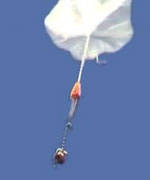
Image credit: ESA
One significant event in the Cassini mission will be when the Huygens probe is deployed to Saturn’s largest moon Titan in early 2005. A team of scientists from the European Space Agency recently tested how their probe will perform on the long drop through Titan’s atmosphere by dropping a replica here on Earth. The mock-up was dropped from an altitude of 33 km on a balloon and it used a parachute to slow its return to Earth. ESA controllers use the descent time to calibrate the instrumentation that will communicate with the real Huygens probe when it makes its visit to Titan.
You need to have thought of almost every eventuality when landing on a distant moon in a remote corner of the Solar System. You must have tested your spacecraft to its limits to be sure it will withstand the extreme conditions expected on Titan, a moon of Saturn.
Moreover, you have to gather in advance as much information as you can about the way your instruments will work in those conditions. It is only when the scientific instruments work properly that you can say your mission has been successful.
Descending through poisonous gas
In early 2005, ESA’s Huygens probe will descend through the cloak of noxious gases surrounding Titan, Saturn’s largest and most mysterious moon. An Italian-led team of European scientists and engineers have ingeniously tackled the challenges of testing the reliability, behaviour, and response of some of the probe’s instruments in actual operation ? not simulations.
Using a combination of balloon and parachute, the team had a creative way of testing a full-scale replica of the Huygens space probe ? they dropped it from 33 kilometres above the Earth! The air we breathe on Earth is very different from the poisonous smog of Titan, but Jean-Pierre Lebreton, ESA Huygens Project Scientist, says that the way in which the properties of our atmosphere change are similar to the behaviour of Titan?s atmosphere.
On 6 June 2003, the scientists gathered at the Italian Space Agency’s Trapani balloon-launch facility in Sicily. To launch the 500-kilogram gondola carrying the mock-up Huygens space probe, they used a helium balloon that fully inflated to a diameter of 100 metres (corresponding to a total volume of 400 000 cubic metres) at its maximum altitude. When the balloon reached a height of 33 kilometres, a release mechanism opened and dropped the probe.
The on-board parachute deployed to slow the probe’s fall from 40 metres per second to just 4 metres per second. At that speed, the probe floated gently back to Earth, taking about 30 minutes to complete its journey beneath the ten-metre-wide parachute. This parachute was designed to provide a fall speed very close to the one expected at Titan.
“Altimeter 1, are you receiving me?”
The flight allowed scientists to collect data under conditions which are as representative as possible in Europe of the future flight to millions of kilometres away from the Earth. In this way, they can really begin to understand the instrument characteristics very well. Scientists call this process calibration.
Not only are these training exercises important to understand the behaviour of the instruments and the data, they also contribute to building team spirit for when the real thrills start at Titan!
This drop was the fourth test flight of the Huygens instruments on Earth (the first such test took place in Spain during 1995, the following two were done in Sicily). This flight was the first to have a fully equipped Huygens mock-up, including the complete Huygens Atmospheric Structure Instrument (H-ASI) provided by Italy. Once on Titan, the purpose of H-ASI will be to study the temperature, pressure, electrical properties, and the winds in this exotic atmosphere.
A mock-up of one of the two Huygens altimeters, mounted on the replica probe was also tested during this balloon flight. The altimeters measure the probe’s height from the ground. “We have analysed the data. From what we have seen so far, the altimeter worked well,” says Lebreton. “The test makes me very confident that the two altimeters on Huygens will work well at Titan.”
“One of the other exciting and comforting aspects of this test flight was to see how good the probe was at stabilising itself during the descent when atmospheric turbulences disturbed the fall, thanks to its special parachute design. We can then confidently expect we will have a flawless drop through Titan?s atmosphere in early 2005,” says Enrico Flamini, ASI Project Manager for Huygens, responsible for this test campaign.
The scientists are now considering a final drop during 2004 over Antarctica. This location is the one on Earth that best resembles Titan’s atmospheric conditions, in terms of pressure, electrical properties, and temperatures. Titan’s temperatures can drop to about ?180?C!
Original Source: ESA News Release
Progress Supply Ship Launches for the Station
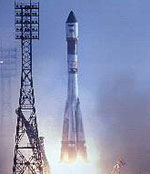
Image credit: RSA
An unmanned Progress 12 supply ship launched from the Baikonur Cosmodrome in Kazakhstan to deliver a new cargo of 2.7 tonnes of food, fuel and water to the International Space Station. The Progress lifted off at 0148 GMT Friday (9:48 pm EDT Thursday) and reached orbit 10 minutes later. The station’s previous Progress, filled with trash, was undocked to make room for the new cargo ship and commanded to re-enter the Earth’s atmosphere and burn up.
An unmanned Russian Progress vehicle successfully blasted off from the Baikonur Cosmodrome in Kazakhstan tonight to deliver almost three tons of food, fuel, water, and supplies to the residents of the International Space Station.
The Progress 12 craft lifted off right on time from its Central Asian launch pad at 8:48 p.m. CDT (148 GMT Aug. 29) as the ISS sailed over the south Atlantic Ocean east of South America at an altitude of 240 statute miles. Less than 10 minutes later, the Progress settled into its preliminary orbit and its solar arrays and navigational antennas were successfully deployed.
Aboard the ISS, Expedition 7 Commander Yuri Malenchenko and NASA ISS Science Officer Ed Lu were already in their sleep period as the Progress climbed to orbit.
The new Progress is scheduled to dock to the aft port of the Zvezda Service Module on Saturday night at 10:45 p.m. CDT (345 GMT Aug. 31). Another Progress ship that arrived at the ISS in February filled with discarded items and trash was undocked yesterday and commanded to deorbit, burning up in the Earth?s atmosphere.
Progress 12 is loaded with supplies for Malenchenko and Lu and science gear for European Space Agency astronaut Pedro Duque of Spain, who is set to launch October 18 from Baikonur on the Soyuz TMA-3 craft with Expedition 8 Commander Mike Foale and Expedition 8 Soyuz Commander and Flight Engineer Alexander Kaleri. Duque will spend eight days aboard the ISS conducting science experiments under a commercial contract between ESA and the Russian Aviation and Space Agency. Duque will return to Earth on Oct. 28 with Malenchenko and Lu.
Among the supplies aboard the Progress is a satellite phone and Global Positioning System locator hardware which Malenchenko, Lu and Duque would use in the unlikely event they land off-course, as did the Expedition Six crew back in May.
The new Progress also carries personal items and hardware for Foale and Kaleri, who are scheduled to spend almost 200 days aboard the ISS.
Another Progress vehicle currently docked to the Pirs Docking Compartment will undock from the ISS on September 4 to clear the way for the arrival of Foale, Kaleri and Duque in the Soyuz TMA-3 on October 20.
Information on the crew’s continuing activities on the Space Station, future launch dates and Station sighting opportunities from anywhere on Earth is available at:
http://spaceflight.nasa.gov/
Details on Station science operations can be found on an Internet site administered by the Payload Operations Center at NASA’s Marshall Space Flight Center in Huntsville, Ala., at:
http://scipoc.msfc.nasa.gov/
The next ISS status report will be issued on Saturday, August 30 following the Progress 12 docking, or sooner if events warrant.
Original Source: NASA Status Report
Earth-Based Telescopes Search for Martian Water
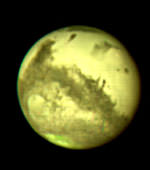
Image credit: UKIRT
Astronomers are searching for evidence of past water on Mars from the comfort of an observatory in Hawaii. They’re using the United Kingdom Infrared Telescope (UKIRT) to map the spectral signature given off of minerals on the Red Planet’s surface. They’re looking for minerals, such as hydrated clay, which would indicate the past presence of liquid water. NASA’s two Mars Exploration Rovers will be searching for similar signs on Mars when they arrive in January 2004.
As Mars makes its closest approach in almost 60,000 years, two Australian astronomers have used the United Kingdom Infrared Telescope (UKIRT) in Hawai`i to look for signs that the planet once had liquid water – and so may have hosted life.
Dr. Jeremy Bailey of the Anglo-Australian Observatory and the Australian Centre for Astrobiology (ACA) at Macquarie University in Sydney, and Sarah Chamberlain, a PhD student at the ACA, have produced what is Bailey says is “perhaps the sharpest image of Mars ever made from the ground.”
But the real gold lies in the spectral data they obtained.
The scientists are applying the same remote-sensing technique that geologists use to map minerals on the Earth’s surface.
Minerals absorb some wavelengths from sunshine and reflect others. Each mineral has its own ‘spectral signature’ – the set of wavelengths it reflects.
“We’re looking particularly for the signatures of minerals, such as hydrated clay minerals, that would indicate the past presence of liquid water,” said Bailey.
Similar prospecting by NASA’s Mars Odyssey spacecraft has shown that there is a vast amount of hydrogen below the surface of Mars. The consensus has been that this is probably water ice.
But did Mars ever have liquid water? And if so, how much? It’s still contentious.
NASA’s Mars Global Surveyor has found sizeable deposits of a mineral called crystalline (grey) hematite, which forms only in the presence of liquid water.
NASA’s two Mars Exploration Rovers, due to land on the Martian surface in January 2004, and the UK lander Beagle 2, due to land in December this year, will also be looking for signs that Mars has had liquid water.
“While spacecraft can get up close, ground-based observations still have a role, as they allow us to use larger and more powerful instruments,” said Bailey.
UKIRT, with a 3.8-m diameter aperture, is the world’s largest telescope devoted specifically to infrared observations.
UKIRT is funded by PPARC, the UK Particle Physics and Astronomy Research Council. The Anglo-Australian Observatory is funded by the UK Government, through PPARC, and the Australian Government.
Observations: Jeremy Bailey (Anglo-Australian Observatory and Australian Centre for Astrobiology, Macquarie University) and Sarah Chamberlain (Australian Centre for Astrobiology, Macquarie University). Data processing: Chris J. Davis, Joint Astronomy Centre, Hawai’i.
Original Source: Joint Astronomy Centre News Release
